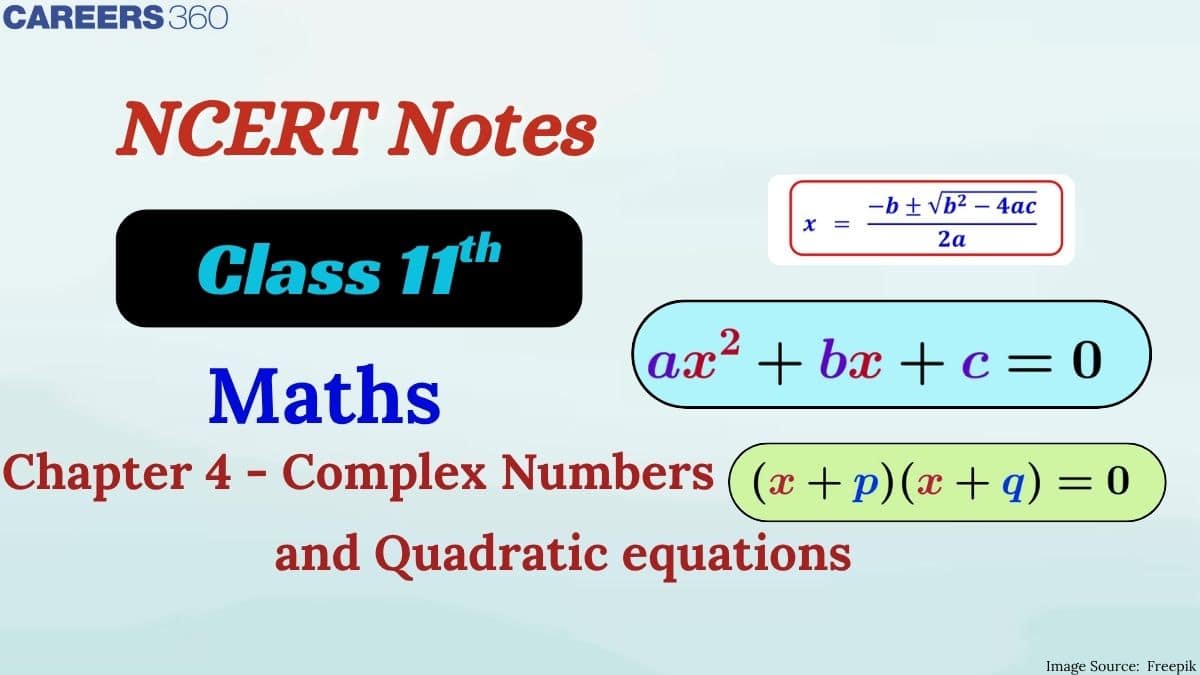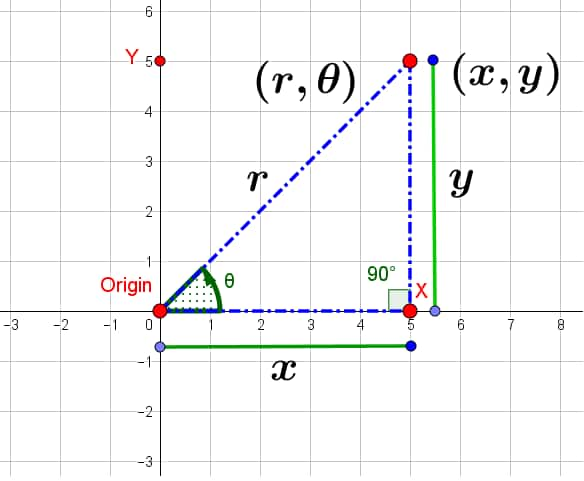Complex Numbers And Quadratic Equations Class 11th Notes - Free NCERT Class 11 Maths Chapter 5 notes - Download PDF
Have you ever tried solving quadratic equations like $x^2+1=0$? Then you will find $x^2=-1$. Is it possible that the square of a real number is $-1$? The answer lies in the chapter on Complex Numbers. Class 12 maths chapter 4, Complex Numbers and Quadratic Equations, contains the concepts of Complex Numbers, Algebra of Complex Numbers, The Modulus and the Conjugate of a Complex Number, Argand Plane and Polar Representation, etc. These concepts will help students grasp more advanced complex-number topics more easily and will also enhance their problem-solving abilities in real-world applications. The main purpose of these NCERT Notes of the Complex Numbers and Quadratic Equations class 11 PDF is to provide students with an efficient study material from which they can revise the entire chapter.
This Story also Contains
- Complex Numbers and Quadratic Equations Class 11 Notes: Free PDF Download
- NCERT Notes for Class 11 Maths Chapter 4 Complex Numbers and Quadratic Equations
- Quadratic Equation Solver
- How to Use the Complex Numbers and Quadratic Equations Class 11 Notes Effectively?
- Complex Numbers and Quadratic Equations Class 11 Notes: Previous Year Question and Answer
- NCERT Class 11 Maths Notes Chapter-Wise Links

After going through the textbook exercises and solutions, students need a type of study material from which they can recall concepts in a shorter time. Complex Numbers and Quadratic Equations Class 11 Notes are very useful in this regard. In this article about NCERT Class 11 Maths Notes, everything from definitions and properties to detailed notes, formulas, diagrams, and solved examples is fully covered by our subject matter experts at Careers360 to help the students understand the important concepts and feel confident about their studies. These NCERT Class 11 Maths Chapter 4 Notes are made in accordance with the latest syllabus, keeping them simple, well-structured, and understandable. Check this NCERT article for complete syllabus coverage along with NCERT Books, Solutions, Syllabus, and Exemplar Problems with Solutions.
Also, read,
Complex Numbers and Quadratic Equations Class 11 Notes: Free PDF Download
Use the link below to download the Complex Numbers and Quadratic Equations Class 11 Notes PDF for free. After that, you can view the PDF anytime you desire without internet access. It is very useful for revision and last-minute studies.
NCERT Notes for Class 11 Maths Chapter 4 Complex Numbers and Quadratic Equations
Careers360 has prepared these NCERT Class 11 Maths Chapter 4 Notes to make your revision smoother and faster.
Complex Numbers and Quadratic Equations help us solve equations that have no real solutions by introducing the imaginary number $i$. This chapter explores how complex numbers work and how they are used to find the roots of quadratic equations.

Complex Number
A complex number is defined as the combination of real and imaginary numbers.
Example: $3+4i$
Here, $3$ is real and $4i$ is the imaginary part.
Here is $i =\sqrt{(-1)}$, then we can say that $i^2 = -1$

Algebra Of Complex Numbers
Addition Of Two Complex Numbers
Let $x=a+ib$ and $y=c+id$
Therefore, $x+y= (a+c) +i(b+d)$
Properties
-
The closure law: The sum of two complex numbers is also a complex number
-
The commutative law: $x+y=y+x$
-
The associative law: $(x+y)+z=x+(y+z)$
Difference Of Two Complex Numbers
Let $x=a+ib$ and $y=c+id$
Therefore $x-y= x+(-y)$
Multiplication of Two Complex Numbers
Let $x=a+ib$ and $y=c+id$
Therefore, $xy=ac-bd+i(ad+bc)$
Properties
-
The closure law: The multiplication of two complex numbers is also a complex number
-
The commutative law: $xy=yx$
-
The associative law: $(xy)z=x(yz)$
-
The distributive law: $x(y+z) = xy+xz$ and $(x+y)z=xz+yz$
Division Of Two Complex Numbers
Let $x=a+ib$ and $y=c+id$
Therefore $\frac{x}{y}$ = $x.(\frac{1}{y})$
Power of $i$
In general, any integer k
$i^{4 k}=1, i^{4 k+1}=i, i^{4 k+2}=-1, i^{4 k+3}=-i$
The square roots of a negative real number
$i^2=-1, \text { and }(-i)^2=i^2=-1$
The Modulus And The Conjugate Of A Complex Number
If $x=a+i b$, then $|x|=\sqrt{a^2+b^2}$
Properties
-
$|x y|=|x||y|$
-
$|\frac{x}{y}|=\frac{|x|}{|y|}$
-
$(xy)'=x'y'$
-
$(x±y)’=x’±y’$
-
$(\frac{x}{y})’=\frac{x’}{y’}$
Argand Plane And Polar Representation
The complex number $a+ib$ corresponding to ordered pairs $(a, b)$ can also be represented geometrically in the XY plane.
In the Argand plane, the modulus of a complex number $a+ib =\sqrt{(a^2+b^2)}$ is the distance from the origin to the point.
Polar Representation Of A Complex Number

We note that the point P is uniquely determined by the ordered pair of real numbers $(r, θ)$ called the polar coordinates of the point P.
We get $a=r\cosθ, b=r\sinθ,$ thus $x=r(\cosθ +i \sin θ)$
Example:
Express the following in the form $\mathrm{a}+\mathrm{ib}: i^{-35}$
Solution : $i^{-35}=\frac{1}{i^{35}}=\frac{1}{\left(i^2\right)^{17} i}=\frac{1}{-i} × \frac{i}{i}=i$
Quadratic Equation
The equation that consists of the highest power in the polynomial is 2.
Let $ax^2+bx+c=0$ be a quadratic equation, then its discriminant is
$D=b^2-4ac$
Let us assume that $D<0$
Then $x=\frac{-b \pm \sqrt{b^2-4 a c}}{2 a}$
Example:
Solve $x^2+x+1=0$
Solution:
Here, $b^2-4ac=1^2-4×1×1=-3<0$
$\begin{aligned} & \text { Therefore, } x=\frac{-b \pm \sqrt{b^2-4 a c}}{2 a} \\ &= \frac{-1 \pm \sqrt{1^2-4 × 1 × 1}}{2 × 1} \\ &=\frac{-1 \pm \sqrt{3} i}{2}\end{aligned}$
Quadratic Equation Solver
Students can use the following link to solve and find the roots of quadratic equations in the form $ax^2+bx+c=0$. Values up to 12 can be checked there. Students can also plot the graph of the quadratic function and examine it at up to four different points. Additionally, the calculator displays key properties such as the discriminant, vertex coordinates, and the sum and product of roots, helping you understand how each coefficient affects the shape and position of the parabola.
How to Use the Complex Numbers and Quadratic Equations Class 11 Notes Effectively?
Complex Numbers and Quadratic Equations is a very important chapter in Class 11 because it helps you deal with numbers that cannot be solved using real numbers alone. When you go through the chapter thoroughly, the ideas become clear and easy to use. Studying with these Class 11 Maths Chapter 4 notes makes the whole chapter more manageable. Here are some more points on how these notes are important.
- Read each topic in order, from Complex Numbers to Polar Representation, to understand how the concepts grow step by step.
- Practice simple problems on algebra of complex numbers, modulus, and conjugates while reading to remember the methods better.
- Connect what you learn from the NCERT Class 11 Maths chapter 4 notes to higher classes, because complex numbers are used in calculus, vectors, and even physics in Class 12.
- Keep revising the NCERT Class 11 Maths chapter 4 notes and solve small questions after each topic to check how much you have understood.
Complex Numbers and Quadratic Equations Class 11 Notes: Previous Year Question and Answer
Given below are some previous year question answers of various examinations from the NCERT class 11 chapter 4 Complex Numbers and Quadratic Equations:
Question 1: If $\alpha$ is a root of the equation $x^2+x+1=0$ and $\sum_{\mathrm{k}=1}^{\mathrm{n}}\left(\alpha^{\mathrm{k}}+\frac{1}{\alpha^{\mathrm{k}}}\right)^2=20$, then n is equal to ______
Solution:
We have,
$\begin{aligned}
& \alpha=\omega \\
& \therefore\left(\omega^{\mathrm{k}}+\frac{1}{\omega^{\mathrm{k}}}\right)^2=\omega^{2 \mathrm{k}}+\frac{1}{\omega^{2 \mathrm{k}}}+2 \\
& =\omega^{2 \mathrm{k}}+\omega^{\mathrm{k}}+2 \quad \because \omega^{3 \mathrm{k}}=1
\end{aligned}$
$\begin{aligned}
& \therefore \sum_{k=1}^n\left(\omega^{2 k}+\omega^k+2\right)=20 \\
& \Rightarrow\left(\omega^2+\omega^4+\omega^6+\ldots+\omega^{2 n}\right)+\left(\omega+\omega^2+\omega^3+\ldots+\right. \\
& \left.\omega^n\right)+2 n=20
\end{aligned}$
Now if $n=3 m, \quad m \in I$
Then $0+0+2 \mathrm{n}=20 \Rightarrow \mathrm{n}=10$ (not satisfy) if $n=3 m+1$, then
$\begin{aligned}
& \omega^2+\omega+2 n=20 \\
& -1+2 n=20 \Rightarrow n=\frac{21}{2} \text { (not possible) } \\
& \text { if } n=3 m+2, \\
& \left(\omega^8+\omega^{10}\right)+\left(\omega^4+\omega^5\right)+2 n=20 \\
& \Rightarrow\left(\omega^2+\omega\right)+\left(\omega+\omega^2\right)+2 n=20 \\
& 2 n=22
\end{aligned}$
$\begin{aligned} & \mathrm{n}=11 \text { satisfy } \mathrm{n}=3 \mathrm{~m}+2 \\ & \therefore \mathrm{n}=11\end{aligned}$
Hence, the correct answer is 11.
Question 2: Consider the equation $\mathrm{x}^2+4 \mathrm{x}-\mathrm{n}=0$, where $\mathrm{n} \in[20,100]$ is a natural number. Then the number of all distinct values of n, for which the given equation has integral roots, is equal to
Solution:
Let us simplify the equation and solve for $x$,
$\begin{aligned}
& x^2+4 x+4=n+4 \\
& (x+2)^2=n+4 \\
& x=-2 \pm \sqrt{n+4} \\
& \because 20 \leq n \leq 100 \\
& \sqrt{24} \leq \sqrt{n+4} \leq \sqrt{104} \\
& \Rightarrow \sqrt{n+4} \in\{5,6,7,8,9,10\}
\end{aligned}$
$\therefore$ $6$ integral values of $n$ are possible.
Hence, the correct answer is $6$.
Question 3: Let $\mathrm{z} \in \mathrm{C}$ be such that $\frac{\mathrm{z}^2+3 \mathrm{i}}{\mathrm{z}-2+\mathrm{i}}=2+3 \mathrm{i}$. Then the sum of all possible values of $z^2$ is:
Solution:
Given:
$\frac{\mathrm{z}^2+3 \mathrm{i}}{\mathrm{z}-2+\mathrm{i}}=2+3 \mathrm{i}$
Apply cross multiplication,
$z^2+3 i=z(2+3 i)-7-4 i$
$z^2-z(2+3 i)+7+7 i=0$
Since it is quadratic, say it has two roots, $z_1,z_2$
$\begin{aligned} & z_1^2+z_2^2=\left(z_1+z_2\right)^2-2 z_1 z_2 \\ & =4-9+12 i-14-14 i \\ & =-19-2 i\end{aligned}$
Hence, the correct answer is $-19-2 \mathrm{i}$.
NCERT Class 11 Maths Notes Chapter-Wise Links
For the convenience of students, Careers360 provides complete NCERT Class 11 Maths notes together in one location. Simply click the links below to access.
Subject-Wise NCERT Exemplar Solutions
After finishing the textbook exercises, students can use the following links to check the NCERT exemplar solutions for a better understanding of the concepts.
- NCERT Exemplar Class 11 Solutions
- NCERT Exemplar Class 11 Maths
- NCERT Exemplar Class 11 Physics
- NCERT Exemplar Class 11 Chemistry
- NCERT Exemplar Class 11 Biology
Subject-Wise NCERT Solutions
Students can also check these well-structured, subject-wise solutions.
- NCERT Solutions for Class 11 Mathematics
- NCERT Solutions for Class 11 Chemistry
- NCERT Solutions for Class 11 Physics
- NCERT Solutions for Class 11 Biology
NCERT Books and NCERT Syllabus
Before the start of a new academic year, students should refer to the latest syllabus to determine the chapters they’ll be studying. Below are the updated syllabus links, along with some recommended reference books.
Frequently Asked Questions (FAQs)
According to Class 11 Maths chapter 4, A quadratic equation is a polynomial equation of the form $ax^2+ bx + c = 0$, where $a, b,$ and $c$ are real numbers and $a ≠ 0$. It represents a second-degree equation, and its graph is a parabola.
A complex number is a number of the form $a + ib$, where $a$ and $b$ are real numbers, and $i$ is the imaginary unit with the property that $i^2= -1$. Here, $a$ is called the real part and $b$ is the imaginary part of the complex number.
Yes, zero is a complex number. A complex number is of the form a + bi, where $a$ and $b$ are real numbers. In the case of zero, both $a$ and $b$ are $0$, so it is written as $0 + 0i$, which is a valid complex number.
According to NCERT Class 11 Maths Chapter 4 (Complex Numbers and Quadratic Equations), imaginary numbers are numbers that are multiples of $i$, where $i$ is defined as the square root of $-1$. They are used to represent solutions of equations that have no real solutions, like $x^2+1=0$.
Complex numbers are represented as points or vectors in the Argand plane, with the x-axis as the real axis and the y-axis as the imaginary axis.
Courses After 12th
Applications for Admissions are open.
As per latest syllabus. Physics formulas, equations, & laws of class 11 & 12th chapters
JEE Main Important Chemistry formulas
Get nowAs per latest syllabus. Chemistry formulas, equations, & laws of class 11 & 12th chapters
JEE Main high scoring chapters and topics
Get nowAs per latest 2024 syllabus. Study 40% syllabus and score upto 100% marks in JEE
JEE Main Important Mathematics Formulas
Get nowAs per latest syllabus. Maths formulas, equations, & theorems of class 11 & 12th chapters
